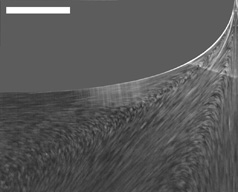We are interested in a wide range of problems from rigorous stability theory (in the function-analytic sense) and differential geometry methods in fluid mechanics to probing Nature with experimental studies. Below a few sample experimental projects are given for illustration. Currently, our experimental focus is on fluid systems with complex interfaces (i.e. in the presence of surfactants and/or chemical reactions at interfaces) as well as short time and small scale phenomena. The experimental research is supported by National Science Foundation, ACS Petroleum Research Fund, Hellman Family fund, and Regents Junior Fellowship.
Flow visualization of the Landau-Levich problem
 |
Dip coating, in which a substrate is withdrawan from a bath, is perhaps the oldest and simplest form of liquid film deposition. The question of film thickness for the vertical withdrawal of a flat substrate in the limit of small capillary numbers and clean interfaces was first addressed theoretically by Landau and Levich. However, deviations in the predicted thickness have been observed in the presence of surfactants. A controversy has existed in the literature with regard to the mechanism which leads to film thickening and the corresponding flow field in the neighborhood of the substrate. This controversy prompted the KFPL to perform flow visualization of the Landau-Levich problem in the presence of surfactants to determine the true topology of the flow field. Using streak photography obtained with a laser sheet, seed particles, a sensitive digital camera, and custom-built plate coating apparatus, members of the KFPL have elucidated the structure of the flow field. |
-
Krechetnikov R., "On application of lubrication approximations to nonunidirectional coating flows with clean and surfactant interfaces," Physics of Fluids 22, 092102 (2010).
-
Diaz R., Mayer H.C., and Krechetnikov R., "Flow visualization of the Landau-Levich problem," APS DFD (2010).
The life of free soap films
 |
The instability that develops along the edge of a retracting liquid sheet, eventually leading to fragmentation and breakup, has attracted considerable attention in the literature. Most of this focus has been of a theoretical nature, examining planar liquid sheets. But, very little experimental work has been completed which can either confirm or counter these predictions due to the inherent difficulty in creating a straight free film edge in the laboratory. Recently we have developed a tool in the KFPL to complete just such experiments. The very early stages of retraction along a straight edge of a free soap film can be captured, using high speed photography, and analyzed. Using this setup it is also possible to examine the life of free soap films - those that have been released along their entire perimeter (as shown in the figure). This method is in stark contrast to the rupture/puncture from a single point in the film, standard practice since the time of Rayleigh (Nature 1891). |
-
Krechetnikov R., "Stability of liquid sheet edges," Physics of Fluids 22, 092101 (2010).
-
Mayer H.C., Krechetnikov R., "The life of a free soap film," APS DFD (2010).
Chemical reaction-driven tip-streaming
 |
In this work we provide a basic physical modeling of the spatiotemporal pattern of emulsification produced by chemical reaction-driven tip-streaming. All the key features of this phenomenon - nonlinear autooscillations, a conical drop shape, tip-streaming, and droplet trajectory splitting - are explained and modelled theoretically. In particular, the experimentally found regimes of self-sustained periodic motion and the transitions between them are explained with the help of a nonlinear relaxation oscillator model. Moreover, a new exact self-similar solution of the Navier-Stokes equations is discovered, which, however, has a singularity at the cone tip. We also study the structure of Marangoni-driven singularities analytically with the help of asymptotic matching of the self-similar and thread solutions using slender jet approximation, which gives explicit asymptotic formulas for the scaling of the thread radius and thus of the emitted droplets as a function of physical parameters. |
-
Krechetnikov R., Homsy G.M., "On physical mechanisms in chemical reaction-driven tip-streaming," Phys. Fluids 16, 2556-2566 (2004).
-
Krechetnikov R., "On the structure of Marangoni-driven singularities," APS DFD (2010).
Crown formation in the drop splash problem
 |
In this project we study the physical mechanisms behind the crown formation in the problem of a liquid drop splashing on a thin film of the same liquid. We provide experimental insights into the nature of the fundamental instability responsible for the crown formation. Our experimental study also reveals the bifurcation picture in the crown behavior as the inertia of the drop is varied, and identifies a few fundamental states characterized by the azimuthal structure of the interface: regular, frustrated, and irregular crown regimes. One of the key questions posed by the drop splash experiments is on the nature and origin of the transition between these states. |
-
Krechetnikov R., "A linear stability theory on time-invariant and time-dependent spatial domains with symmetry: the drop splash problem," Dynamics of PDE 8, 47-67 (2011).
-
Krechetnikov R., Homsy G.M., "Crown-forming instability phenomena in the drop splash problem," J. Colloid Interface Sci. 331, 555-559 (2009).
-
Krechetnikov R., Homsy G.M., "On the crown forming instability in the drop splash problem," APS DFD (2006).